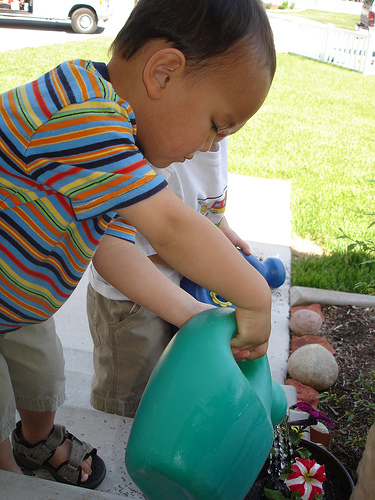Ethnography Examples and Go and See in Lean Manufacturing go hand in hand, no pun intended (as you’ll better understand if you read on). Observational Research is very important.
The Toyota Production System makes effective use of visual cues to mark location in time and space, boundaries, and to answer the questions “How am I doing?”, “Where am I?”, “How do I use this?”, and “What else needs to be done?”. Visual Cues are a simple but effective mechanism.
The assumption ” and, what empirical evidence supports ” is that we react and adjust automatically to objects and spaces that we encounter. I saw evidence of this recently: the picture below is my son watering flowers. Notice how he is holding the watering can:
The weight of the watering can is mostly distributed toward the bottom, yet my son is holding the handle with both hands at the top of the can. For him, it is probably “natural” to hold the handle, because that is what the object provides us. But, the handle is “unnatural” in the sense that it is ergonomically unfit for the complicated biomechanics of the hand and the weight distribution of the water. Arguably, my 3-year old son is struggling with the weight of the watering can and is consequently spilling water outside the target of the plant because the weight is causing him to be unbalanced.
Now, notice my other 3-year old son (yes, they are twins):

Notice how my other son is holding the bottom of the watering can? He did this as a natural response to the weight of the object. In other words, holding the bottom allowed him to be more balanced and have more control over the object. On the other hand, my other son had more fidelity to the handle, because that is what the object provided him.
Some design camps would call the design of the watering can above “not humane”, because it doesn’t allow the user of the object to be successful in their use of the object. I side with that camp. A book that I highly suggest is The Humane Interface: New Directions for Designing Interactive Systems, written by the insightful Jef Raskin, the founder of the Macintosh. His son, Aza (and fellow University of Chicago alum), is continuing Jef’s legacy of humane design and is the founder of a design consultancy called Humanized. Perhaps Aza would be open to an interview on shmula.com someday. Aza?
Back to the can: If you were a watering can manufacturer, how might you modify the design of the watering can to better fit the mechanics of a 3-year old hand and physiology? What would you do?
Another book I highly suggest buying is Thoughtless Acts?: Observations on Intuitive Design ” a highly recommended book. This book fully supports the notion visual management that Toyota teaches so well. The background in anthropology, however, adds a dimension that adds clarity and insight into why we do the things we do, and why we respond in particular ways to objects around us.
More articles on Genchi Genbutsu and Ethnography?









If I was at home I’d take a photo, but our watering can has a large handle that curves from the front and connects to the bottom of the can…. about 270 degrees of arc I suppose. You can then pick it up with one hand (ok, two if it is full!), hand exactly where needed to suspend it easily while angling it to pour just the right amount.
Nice looking twins!
Kevin
No suprise that Pete has the 3-year olds earning their bread by the sweat of their brow. The legacy continues!